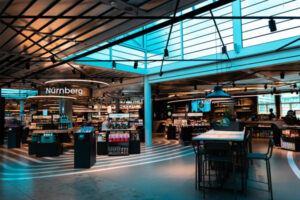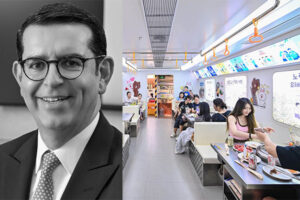ACROSS: SES will operate Austria’s first managed shopping street in Seestadt Aspern in Vienna. What does that mean?
MARCUS WILD: Allow me to give you the long version: As a group company within the Spar Austria Group, SES’s roots are in the food retail trade. Its organizational roots are thus in a company that was originally a wholesaler working in partnership with independent retailers – comparable to today’s malls. Spar initially allowed these traders to operate under their own branding. Spar is meanwhile the largest local provider, and SES is the largest shopping center operator, in Austria. The “Spirit of Retailing” is thus embedded in our genes.
Regarding Aspern: Due to the importance of retail for cities, financial investors naturally want to get involved. Our approach, however, stems from retail itself. That’s because marketplaces arise where people come together – in meeting places. I’ve mentioned how vast our experience is in this segment and this has enabled us to get involved early on in the planning of the shopping street. For the first managed shopping street in Austria, we founded a joint venture with the City of Vienna. We’re currently concerned with the managed shopping street’s development schedule. The site is being developed in accordance with the master plan. Thanks to the horizon of our experience, we can contribute to its success. In this capacity, we rent all the designated areas as a general tenant and then manage the subletting. The first 13 shops will all open by summer 2015. The second phase of the development, the Seeparkquartier, is currently under construction. I find the Seestadt Aspern “experiment” very exciting. A city within a city is arising there that will be home to 20,000 residents when completed.
We are aware that the shopping street will not enjoy high frequency from the day one. The street will also never compete with the likes of Mariahilfer Straße. It will also have to exist with restrictions during the first few years; on the one hand because not all the residences are inhabited, on the other hand because the construction per se brings disadvantages.

ACROSS: What do you look for regarding the tenant mix?
WILD: The tenant mix of course focuses on the basic needs of local supply. We are talking about groceries, a drugstore, a bakery, a hairdresser, a pharmacy, some restaurants, etc. But we’re realistic. We are aware that the shopping street we’re managing in Aspern will not be a supra-regional “shopping destination”, it will be a local one.
ACROSS: What risks and opportunities do you see?
WILD: When a city is under pressure, every homeowner in a shopping street logically seeks to maximize rental income. That can set a downward spiral in motion. It can, for example, mean that a shopping street is unable to fulfill essential functions. In addition, owners often lack an adequate capital cushion to support major tenants in the initial phase. We want to defy these teething problems for shopping streets in Aspern. That’s why we are handling the subletting as a general tenant, as mentioned. That carries risks for us, of course. On the other hand, this provides security for the developers. There are some who think they could have achieved greater subleasing themselves. In general, we are treading a very innovative path here that requires courage. Our main drive in Aspern is not to earn loads of money. Instead, we want to acquire expertise in a field of business we believe will be more important in the future because cities will deal more intensively with the issue of managing shopping streets.
ACROSS: How did the joint venture come into being?
WILD: Our center Q19 is an example of very gently inserting a district shopping center into what was a somewhat declining retail landscape in Vienna-Döbling. Dealing with a listed façade and one of the oldest reinforced concrete buildings in the city made the project challenging. That caught the attention of the city administration. On top of that, we have a very good reputation in the rental market. The City of Vienna has considerable confidence in SES.
ACROSS: Do those responsible in cities think too short term? Where is your focus on?
WILD: We have to get used in general to thinking in ten-year perspectives and to seeing lines for prospective development. It’s about the right direction. We are in a period of urbanization. In 2030, more than 50% of people worldwide will live in cities. This forecast also concerns Austria, of course. Vienna therefore is an extremely interesting spot for SES. It is enormously important for us how we move forward in Vienna and its surrounding areas. An example, is the new construction and redevelopment of Huma Shopping Park in Vienna-Simmering, which will open next spring and will make it one of Vienna’s biggest and most state-of-the-art shopping centers. In addition, the extension of Fischapark in Wiener Neustadt is one of our biggest investments. We have about 42,000 sq m of GL A there – with Peek & Cloppenburg and Zara. We have a small center, Mariandl in Krems, in our portfolio. With Huma Shopping Park, Gerngross, Q19, and the shopping street in Seestadt Aspern, we’re following a very urban path in Vienna. In sum, SES is extremely active in the Austrian capital and its environs. The fact that we are developing centers in district capitals like Ried fits this strategy.
ACROSS: What makes the project in Ried stand out?
WILD: The 22,000-sq-m-GLA Weberzeile in Ried, Upper Austria, is located right in the middle of the town. A serious issue in Ried is the fear that the new shopping center will affect urban retail. The city went through several years of retail evolution. Since few anchor stores are present, this led to an erosion of sales. When Weberzeile opens at the end of August, it won’t just be an evolution, but a revolution that will change people’s shopping habits and it will have a general positive effect on the city and its catchment area. Certain retailers in the town might now experience heavy competition in their segments. For them it will be difficult. If we consider the situation in five or six years, however, we will find that this development was absolutely right. Ried will once more be able to position itself as a retail city.

ACROSS: On to gastronomy concepts, which are constantly gaining importance in shopping centers. SES is one of the pioneers in this regard. What function does gastronomy fulfill in malls from today’s perspective?
WILD: In my opinion, urbanity can be defined in greater detail by speaking of urban quality of stay. Once people put feelings into play, that quality of stay increases – and urbanity isn’t only found in the center of a city. I therefore believe that one of the most important topics surrounding the meeting place element of a shopping mall is what gastronomic concepts one provides. The more varied the better. Take the example of Europark Salzburg: The spectrum ranges from a McDonald’s and a Starbucks, to an Italian, an Asian, a pastry shop, an ice cream parlor, and a gourmet restaurant. A journalist recently told me that there are not enough good food concepts for shopping centers. I countered that there are not enough good shopping centers for excellent foodservice providers. One also has to make sure that customers are happy to sit in the food court. Ceilings and floors must be up to scratch. Guests have to feel safe and cozy and have a good view. These points are exactly where one can tell whether a shopping center developer has been thinking about the future. Whether they have been thinking about the liveliness of the center. SES’s philosophy may be a bit different, because we build, manage, and own our own malls. Our approach with all our objects is therefore to build them with the greatest possible emotional dedication. In case of center management mandates we act just as responsibly. Nevertheless, it is a public space.
ACROSS: Online retail has been challenging shopping center operators for quite some time now. What concepts is SES applying to overcome this problem?
WILD: The branch is in the midst of a repositioning process. This ‘problem’ is a challenge and cannot be covered in a nutshell. One must raise the question here of what a retail shop even is. I refer to the well-known 20th century media researcher Marshall McLuhan. He said: “The medium is the message.” A bricks-and-mortar retail business is nothing more than a message – specifically a brand message. This message is fantastic because it best represents a meeting place in our genes. A bricks-and-mortar unit has the greatest relevance when it comes to emotional branding. This comes in the context that we are living in a time of massive complexity in communication. We need to simplify this complexity by offering a communicative presence of the brand. What does this mean in a nutshell? Changing communication is a huge effect because smartphones have mutated into a part of our brains. It makes us a world-organism. Smartphones make us open to many influences on our behavior and put us on under their thumb. An understanding of the new type of consumer and his/her communication habits is a precondition for brand presence. In this evolutionary process brands prevail more often as mono-brands – a growing number of brands are following the same success analogy and open their own outlets. This doesn’t mean, however, that all multi-brand stores will disappear. However, their disadvantages are obvious. Innovation with regard to product range and services is their key to success. Look at Germany! From 2001 to 2013, 20,000 retail textile stores disappeared in Germany. Who replaced them? Mostly mono-brand stores. We notice more and more integrated retailers like H&M, Zara, Primark, etc. None of them offer any other brands in their stores. And many well-known retail mono brand stores are among the leaders in the virtual sales area as well. The retail landscape thus altered by communication exerts extensive pressure. This applies to all segments. In summary: “The store is the message.” In the survival of the fittest, it is not a question of online or bricks-and-mortar. Total branding and omni-channel are the keywords.
ACROSS: What does “The store is the message” mean for shopping center operators?
WILD: A lot more brands are coming onto the market. It seems to be of almost existential importance for consumer brands to have physical stores. Many stores forego traditional advertising altogether, but more and more brands are recognizing the communicative necessity of having their own stores. Concepts like Inditex (Spain), the Varner Group (Norway) or LPP (Poland) have many mono brands. They establish a very clear line in each segment. On one hand, therefore, more brands will enrich the market. On the other hand, it means that these brands need to be close to many other brands. This means that dominant shopping centers have a good opportunity – they are important stages for brands. That does not change the fact that revenues are migrating to the internet.






